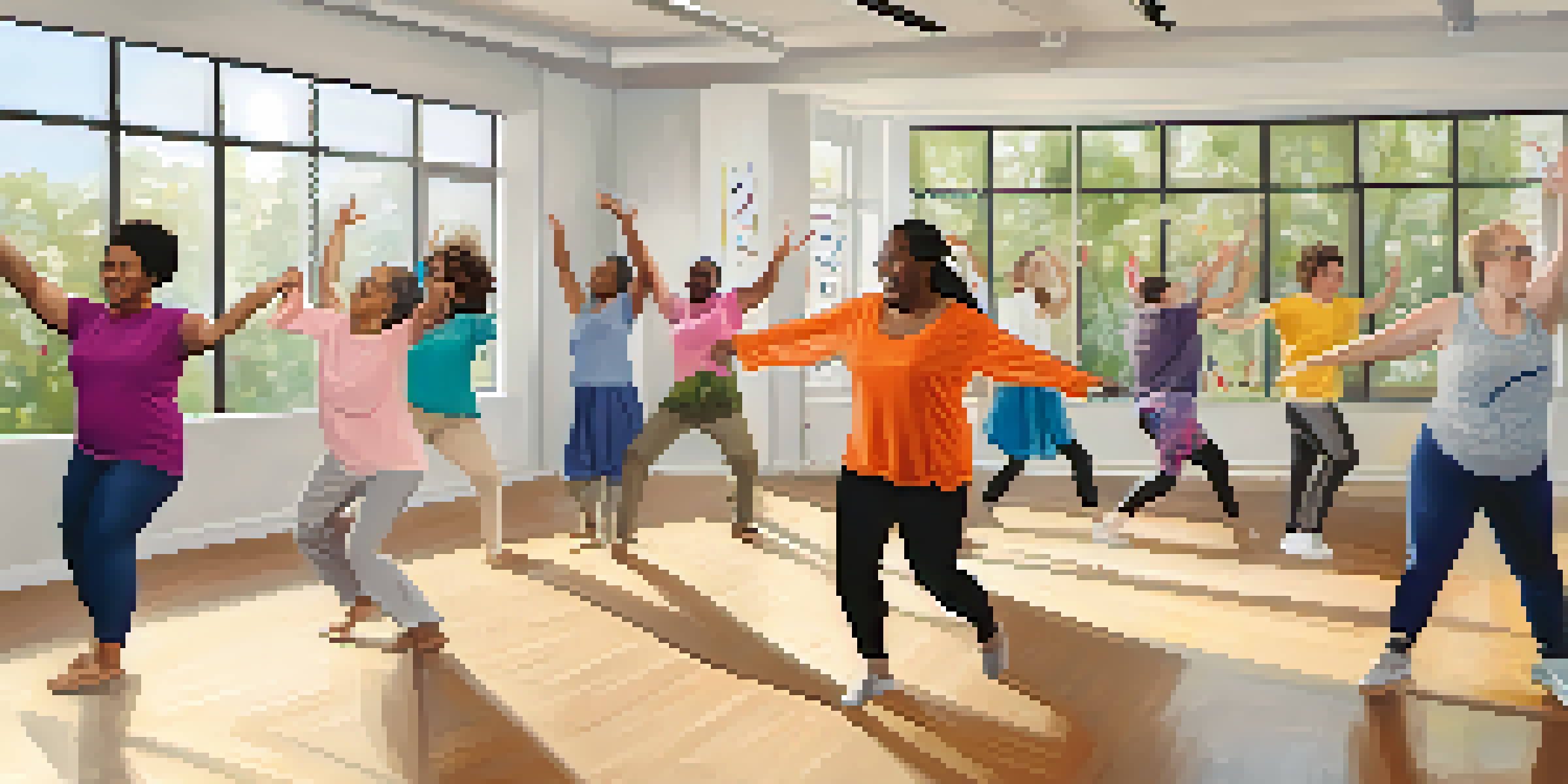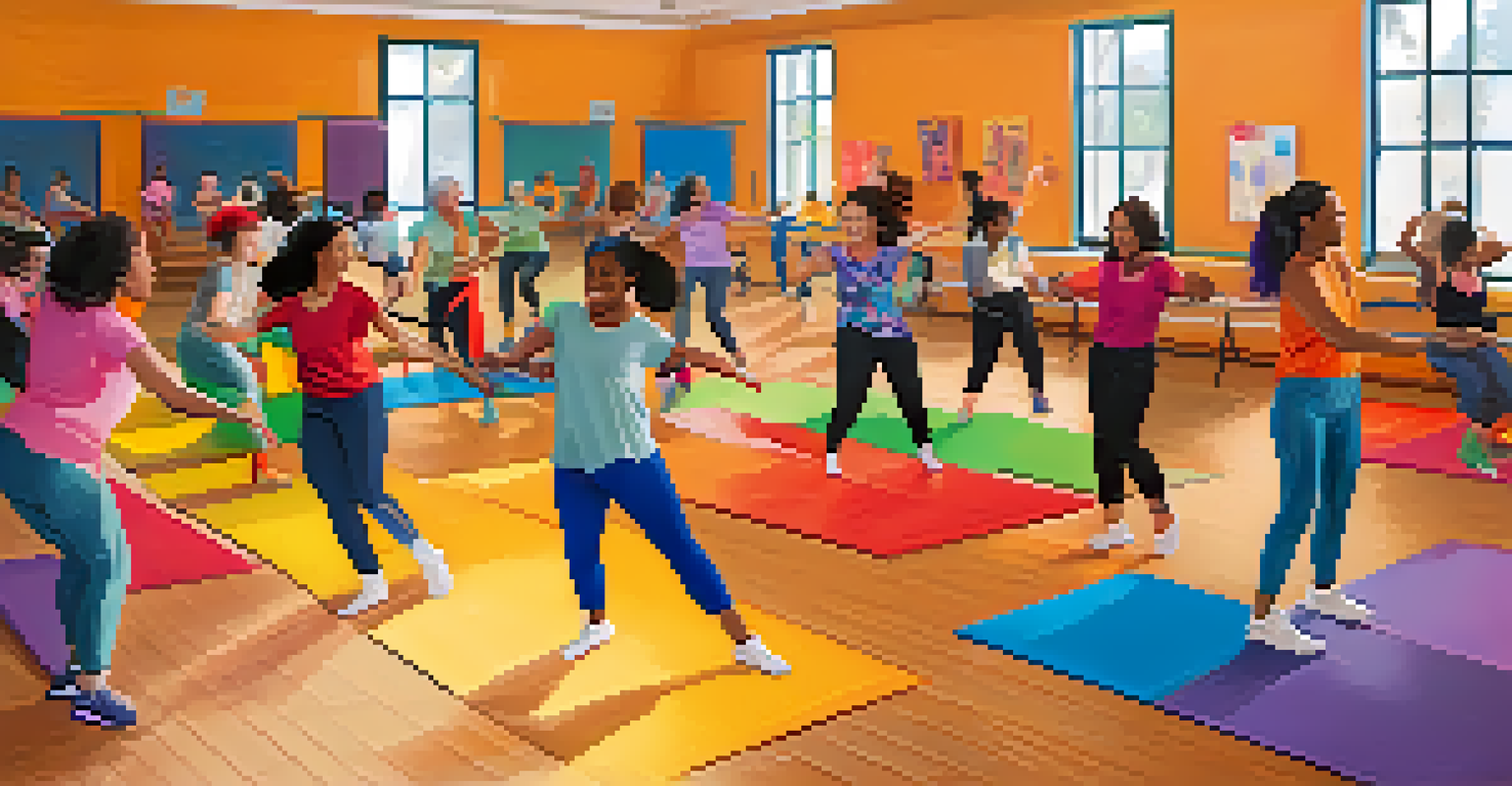Exploring Dance Therapy as an Adaptation for Disabilities

Understanding Dance Therapy and Its Purpose
Dance therapy, also known as dance/movement therapy (DMT), is a form of expressive therapy that utilizes movement to promote emotional, cognitive, and physical integration. It is especially beneficial for individuals with disabilities, providing them an alternative mode of communication and expression. By incorporating body movement, dance therapy encourages participants to connect with their emotions in a safe and supportive environment.
Dance is the hidden language of the soul.
This therapeutic approach is rooted in the belief that the body and mind are interconnected. This means that movement can influence emotional healing and provide a unique pathway for self-discovery. Dance therapy allows individuals to express feelings that might be difficult to verbalize, helping them to explore their identities in new and meaningful ways.
Through guided movement, participants can develop self-awareness, improve motor skills, and enhance social interactions. Whether it's through improvisation, choreographed routines, or simple rhythmic movements, dance therapy adapts to fit the needs and abilities of each individual, making it a versatile option for many.
The Benefits of Dance Therapy for Individuals with Disabilities
Dance therapy provides numerous benefits that can significantly enhance the quality of life for individuals with disabilities. One of the most notable advantages is the boost in self-esteem and confidence that comes from learning to express oneself through movement. As participants engage in dance, they often experience a sense of achievement that can translate into other areas of their lives.

Additionally, dance therapy can improve physical coordination and mobility, which are often areas of concern for those with disabilities. The structured movement routines not only facilitate physical fitness but also help participants gain better control over their bodies. This can lead to improved overall health and well-being, encouraging a more active lifestyle.
Dance Therapy Enhances Self-Expression
Dance therapy allows individuals to express emotions and explore identities through movement, fostering personal growth.
Moreover, the social aspect of dance therapy cannot be overlooked. Group sessions foster a sense of community and belonging, allowing individuals to connect with others who may share similar experiences. This shared journey of exploration through dance can lead to lasting friendships and support networks.
Adapting Dance Therapy for Different Disabilities
One of the remarkable features of dance therapy is its adaptability. Whether working with individuals with physical disabilities, developmental disorders, or mental health challenges, dance therapy can be tailored to meet specific needs. Therapists often assess the capabilities of each participant and design sessions that align with their unique strengths and limitations.
Movement is a medicine for creating change in a person's physical, emotional, and mental states.
For instance, those with mobility challenges may engage in seated dance exercises or use adaptive equipment to facilitate their participation. In contrast, individuals with developmental disabilities may benefit from structured routines that promote rhythm and coordination. The versatility of dance therapy ensures that everyone has the opportunity to participate and thrive.
Furthermore, therapists are trained to modify movements, provide support, and encourage creativity, allowing participants to explore their abilities without the pressure of perfection. This individualized approach not only enhances the therapeutic experience but also empowers individuals to discover new ways of moving and expressing themselves.
The Role of a Dance Therapist
A dance therapist is a trained professional who specializes in using movement as a therapeutic tool. Their role extends beyond simply teaching dance; they are skilled in assessing the emotional and physical needs of their clients. By creating a safe and supportive environment, dance therapists help participants explore their feelings and experiences through movement.
In therapy sessions, the dance therapist guides participants through various activities and encourages self-expression. They observe how individuals respond to different movements and adjust their approaches accordingly, ensuring that each participant feels comfortable and engaged. This adaptability is key to fostering a positive therapeutic experience.
Improves Physical and Social Skills
Participants in dance therapy can enhance their physical coordination and social interactions, leading to improved well-being.
Moreover, dance therapists often collaborate with other healthcare professionals to create a holistic treatment plan. This interdisciplinary approach allows for a comprehensive understanding of each individual's needs, ultimately enhancing the effectiveness of the therapy. By prioritizing the client's overall well-being, dance therapists play a crucial role in their healing journey.
Case Studies: Success Stories in Dance Therapy
There are numerous inspiring success stories that showcase the effectiveness of dance therapy for individuals with disabilities. For example, a young girl with autism found her voice through dance, gaining confidence and improving her social skills. Her journey demonstrates how movement can open up new avenues of communication and self-expression.
Another case involved a man with cerebral palsy who used dance therapy to enhance his physical coordination and mobility. Over time, he not only improved his physical abilities but also discovered a newfound joy in movement, which positively impacted his mental health. His story highlights the profound impact dance therapy can have on both body and spirit.
These case studies serve as powerful reminders of the transformative potential of dance therapy. By providing individuals with the tools to express themselves and connect with their bodies, dance therapy encourages personal growth and resilience, making it a valuable resource for those with disabilities.
Incorporating Dance Therapy into Rehabilitation Programs
As the benefits of dance therapy become more widely recognized, many rehabilitation programs are beginning to incorporate it into their treatment plans. By including dance therapy, healthcare providers can offer a more comprehensive approach to rehabilitation that addresses both physical and emotional needs. This integration can lead to improved outcomes for individuals undergoing various therapies.
For instance, integrating dance therapy into physical rehabilitation can enhance motivation and engagement. Patients may find traditional exercises more enjoyable when combined with movement and music, leading to increased participation and adherence to their treatment plans. This approach not only fosters physical healing but also promotes emotional well-being.
Adaptable for Various Disabilities
Dance therapy is versatile and can be tailored to meet the unique needs of individuals with different disabilities.
Moreover, healthcare professionals can collaborate with dance therapists to create tailored programs that align with specific rehabilitation goals. By working together, they can ensure that each individual's therapeutic journey is well-rounded and holistic, ultimately enhancing the overall effectiveness of the rehabilitation process.
Conclusion: The Future of Dance Therapy in Disability Care
Dance therapy is emerging as a powerful tool for empowering individuals with disabilities. By facilitating self-expression, improving physical abilities, and fostering social connections, dance therapy holds the promise of enhancing the quality of life for many. As awareness of its benefits continues to grow, more individuals and healthcare providers are likely to embrace this innovative approach.
Looking ahead, ongoing research and advocacy are crucial for integrating dance therapy into mainstream disability care. By supporting initiatives that promote dance therapy, we can help ensure that more individuals have access to these transformative experiences. Initiatives can include training more dance therapists and raising awareness about the benefits of dance therapy.

Ultimately, dance therapy offers a unique and enriching pathway for individuals with disabilities to explore their potential. As we continue to explore and expand upon this therapeutic approach, we can create a more inclusive and supportive environment for everyone to thrive.